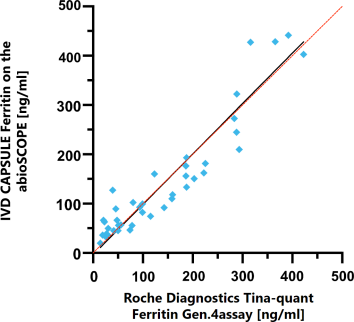Screening for Iron Deficiency through Ferritin Blood Levels

Iron deficiency affects up to one third of the world’s population and is one of the leading risk factors for disability and death worldwide 1. Yet, it is still underdiagnosed and undertreated 2. Iron is essential for the body’s proper functioning and is needed to maintain energy levels and concentration, thus, an iron deficiency can leave patients feeling fatigued, unable to concentrate and cold.
It is therefore essential to assess the body’s iron reserves. Ferritin has been scientifically and clinically validated for this purpose and can be conveniently measured on the abioSCOPE®.
Excellent correlation between test results on the abioSCOPE® and a laboratory reference method
An excellent correlation was found between the two methods shown in Figure 1.
This highlights the clinical ability of Abionic’s point-of-care Ferritin solution to revolutionise the diagnostics for patients, by providing accurate and quantitative whole blood test results within approximately 5 minutes.

The abioSCOPE® optimises the clinical management of patients by enabling healthcare practitioners to provide immediate personalised advice on diet and/or treatment.
Abionic is the first company to bring a Quantitative Ferritin Blood Test to the point-of-care
FAQ
The abioSCOPE® simplifies the steps needed for patients to obtain their ferritin diagnosis, thus enabling healthcare practitioners to immediately prescribe an adequate treatment.
The test can be performed easily by any healthcare practitioner after a simple training on the device and the test handling procedure.
When comparing the IVD CAPSULE Ferritin assay against the Tina-quant Ferritin Gen 4 assay (Roche Diagnostics), an excellent linear correlation is seen between the two methods, meaning they have very similar performances.
References